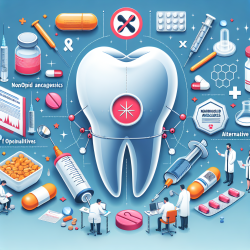Introduction
In the realm of dental care, managing acute pain effectively and safely is paramount. The recent research article titled "Evidence-based clinical practice guideline for the pharmacologic management of acute dental pain in adolescents, adults, and older adults" provides groundbreaking insights into how practitioners can improve patient outcomes by utilizing nonopioid analgesics. This blog explores the key findings and implications of this study, offering practitioners actionable insights to enhance their clinical practice.
Key Findings
The study, conducted by a panel of experts from the American Dental Association Science and Research Institute, the University of Pittsburgh, and the University of Pennsylvania, emphasizes the superiority of nonopioid medications over opioids for managing acute dental pain. The research highlights that nonsteroidal anti-inflammatory drugs (NSAIDs), alone or combined with acetaminophen, offer better pain relief with fewer side effects compared to opioids.
- Nonopioid Medications: NSAIDs and acetaminophen are recommended as first-line therapies for managing acute dental pain post-extraction.
- Opioid Use: Opioids should be reserved for cases where nonopioid medications are contraindicated or insufficient.
- Safety Profile: Nonopioid medications have a more favorable safety profile, reducing the risk of adverse outcomes associated with opioids.
Practical Implications for Practitioners
For practitioners, the implications of this study are profound. By integrating these evidence-based guidelines into practice, clinicians can significantly improve patient outcomes while minimizing the risks associated with opioid use. Here are some practical steps:
- Adopt Nonopioid First-Line Therapy: Use NSAIDs and acetaminophen as the primary approach for managing acute dental pain.
- Educate Patients: Discuss the benefits and risks of different pain management strategies with patients, emphasizing the safety of nonopioid options.
- Implement Shared Decision-Making: Engage patients in the decision-making process to tailor pain management strategies to their preferences and needs.
Encouraging Further Research
While this study provides a robust framework for managing acute dental pain, it also highlights areas for further research. Understanding patient preferences and the long-term effects of analgesic use remains crucial. Practitioners are encouraged to contribute to ongoing research efforts and stay informed about emerging evidence to continually refine their practice.
Conclusion
The transition from opioid to nonopioid analgesics in managing acute dental pain marks a significant advancement in dental care. By adopting these evidence-based guidelines, practitioners can enhance patient safety and outcomes. To delve deeper into the original research and explore its comprehensive findings, please follow this link: Evidence-based clinical practice guideline for the pharmacologic management of acute dental pain in adolescents, adults, and older adults.










